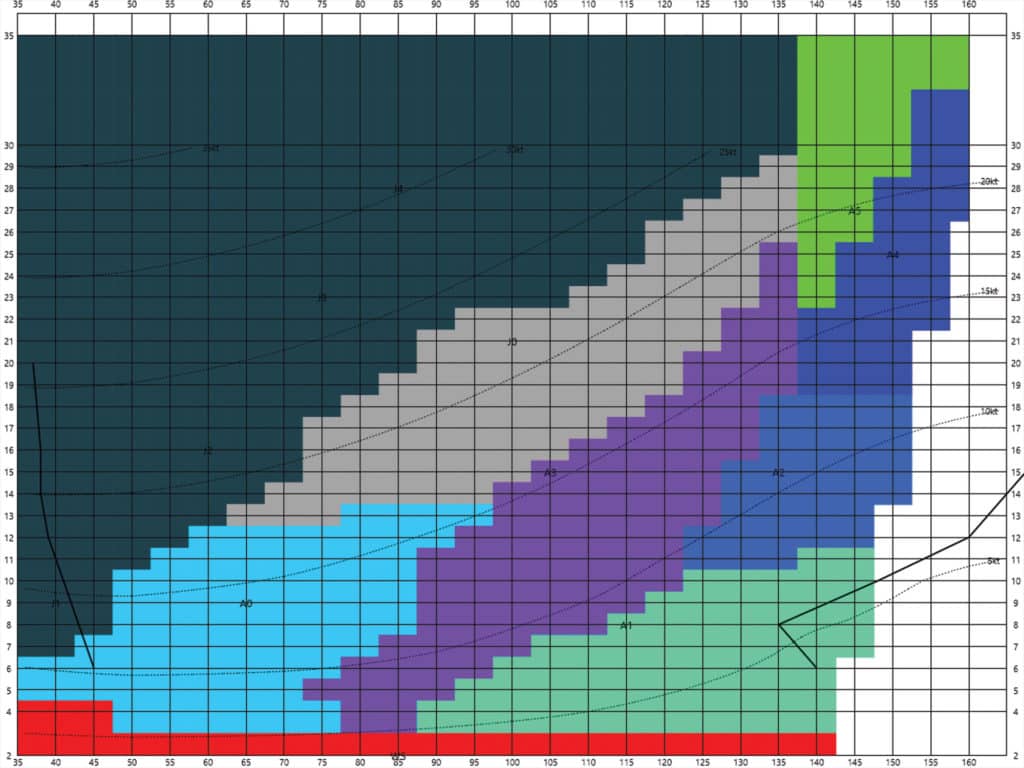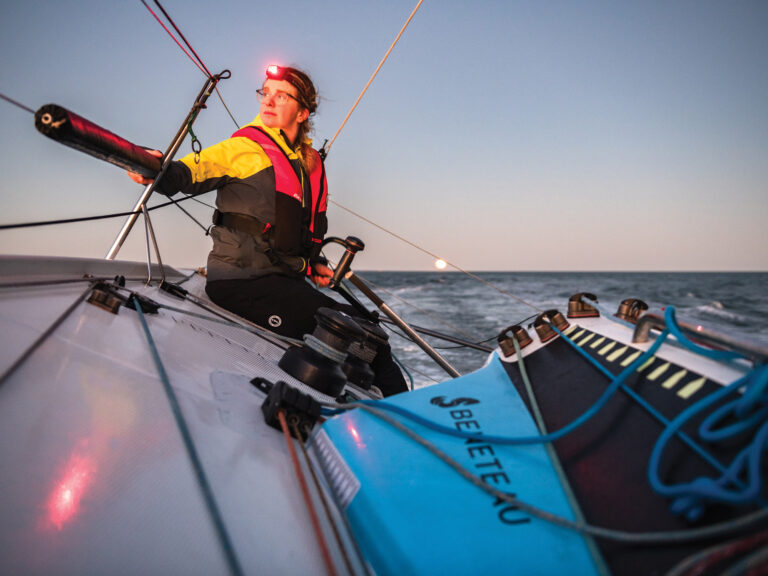
Triple-headed sail inventories are becoming more popular these days, but the question is, does this setup actually make your boat go faster or simply add more complexity? I remember not too many years ago during a race when someone suggested we hoist the staysail and see if we picked up half a knot of boatspeed. We did, and then after a while everyone was convinced we should take the staysail down. We did, and what do you know? We picked up half a knot. At the time, I guess we really didn’t have the right answer, but we sure had a lot of opinions. Fortunately, with today’s technology we have data to back up what sail selection is fastest.
Last year, the team on Andrew Clark’s J/122 Zig Zag wanted to develop a sail inventory specifically for the Newport Bermuda Race. Clark reached out to me, looking for a sail package that would give Zig Zag the best solution to win. Throwing a bunch of sails at the problem wasn’t the solution because there are many factors that can influence the decision on the ideal sail inventory—rating rules, anticipated wind conditions, number of sails and weight.
The first thing we did was look at the historical conditions of the Bermuda Race and determine the percentages we would spend sailing at each wind angle and wind strength. Typically, the Bermuda Race is slightly lighter, with a lot of conditions changing as you enter the Gulf Stream. This told us we had to make sure we had all our bases covered.
The second element we looked at was the number of sails and the total weight of the inventory. If we can reduce the number of sail changes during a race, the less time we can spend sailing below target speeds. Sail changes are costly, and if there is a chance to reduce the number of changes without giving up performance, that needs to be factored into the equation.
The third element is the rating rule. Every rule is different, and special attention needs to be taken to evaluate sail size and the type of sail entered for the certificate. Some rating rules allow you to submit a test certificate to see how the changes affect the rating.
The last element is the quiver of sails that will make up the inventory and be applied to the rating certificate. This step is where the project team looks at everything, weighs the pros and cons, and comes up with a solid inventory of sails that it can then use to build a polar chart specific to the J/122 and the selected set of sails.
After a sail-configuration analysis, the team at Evolution Sails recommended a triple-headed reaching setup that would increase reaching speeds based on the current sail configuration Zig Zag was already using. The triple-headed setup includes a J Zero, jib and gennaker staysail. The J Zero is designed to be a smaller and flatter sail than the traditional larger Code Zero. It’s flown off the bowsprit with a furler and is also referred to as a flying jib. The gennaker staysail is a flat and smaller sail that fits in between the jib and the mast. With the J Zero deployed on the bow pole, the jib can be flown off the forestay as it always is, and then the gennaker staysail is set up between the forestay and mast trimmed inside the jib.
This setup improves the performance better than the traditional inventory options. What we found in previous sail inventories is that tight-reaching configurations consisted of a jib and a gennaker staysail. An additional sail that was historically designed for reaching was the Jib Top, which is a high-clew jib that can be trimmed easier on a reach than a standard jib.
Once the sails were designed, built and delivered, the hard work of sail testing began. The goal here was to build a polar table and sail chart that would guide us through which sail we should have up in specific conditions. Polars are calculated speed versus wind angles that take sail inventory into consideration and can be found from the manufacturer for most boats. What the manufactured polars don’t consider, however, is the sail inventory itself.

The best way to create polars, of course, is by sailing the boat with the sail configurations. Zig Zag uses Expedition software to log actual performance versus the calculated polars the design team compiled. We were able to correct the performance of each sail and configuration, and edit the tables in Expedition to help guide us through the race. We then updated the polars and created a sail chart that showed which sail should be used based on specific wind angles and windspeeds. This process takes time and practice. You need to sail the boat in many sail configurations at each wind angle to find the ideal setup. Zig Zag did several practice days with the triple-headed arrangement in order to log the speed performance versus other configurations.
Expedition software is one of the best sailing software tools on the market. It does an unbelievable job with navigating, but it also helps develop the polars and sail configurations. To have good data from Expedition, however, the electronics on the boat must be calibrated properly. This is the most difficult part of the equation because it is very complex to get accurate. If the data that feeds Expedition is not accurate, the sail and polar analysis will not be accurate. Having a dedicated person who knows the instruments and can calibrate them on an ongoing basis is a key element to have a successful program. With accurate data and a lot of sail testing, Expedition creates data files called strip files. These files contain the data to analyze and also can be sent to a third-party analyst to do the comparison.
Once we were ready to race with an Expedition update and the forecast in hand, we could see which sails we were projected to use throughout the race. This gave us an overall idea of when sail changes needed to happen and which sails we would be looking at using next based on the forecasted wind models.
How do we configure the foredeck to handle all these sails? The pole length is fixed and the forestay is fixed, so those two points are easy. The location for the gennaker staysail forestay is what we needed to figure out. When we looked at the J/122, we needed a mast attachment point and a deck point. We wanted to set the gennaker staysail forestay about two-thirds forward between the forestay and mast, which would allow it to fit between the jib and mainsail, with the leech of the sail just touching the lower shroud.
Once we found that point, we added a soft-shackle attachment point into the deck and an attachment point on the mast near the top set of spreaders.
With all three flying, the jib could be trimmed off a barber-hauler sheet and the primary jib sheet depending on the wind angle. The J Zero is trimmed to an outboard sheet, and the gennaker staysail is trimmed to a cabin-top attachment point that we installed on top of the turning blocks, which gave it the right trimming angle. For different types of boats, you will need to sit down with the sail design team and look at all these issues to be able to design the gennaker staysail and J Zero to fit and be trimmed properly.
Going to the triple-headed sail configuration helped the Zig Zag team improve the overall performance of the boat based on the data analysis. For future races and practices, we will continue to evaluate and tune the numbers to help improve the overall base-line polars. This is an iterative process, and it’s what makes sailboat racing so dynamic and a huge passion for many people. And as for the Bermuda Race results? Team Zig Zag finished first in its division and second overall.









